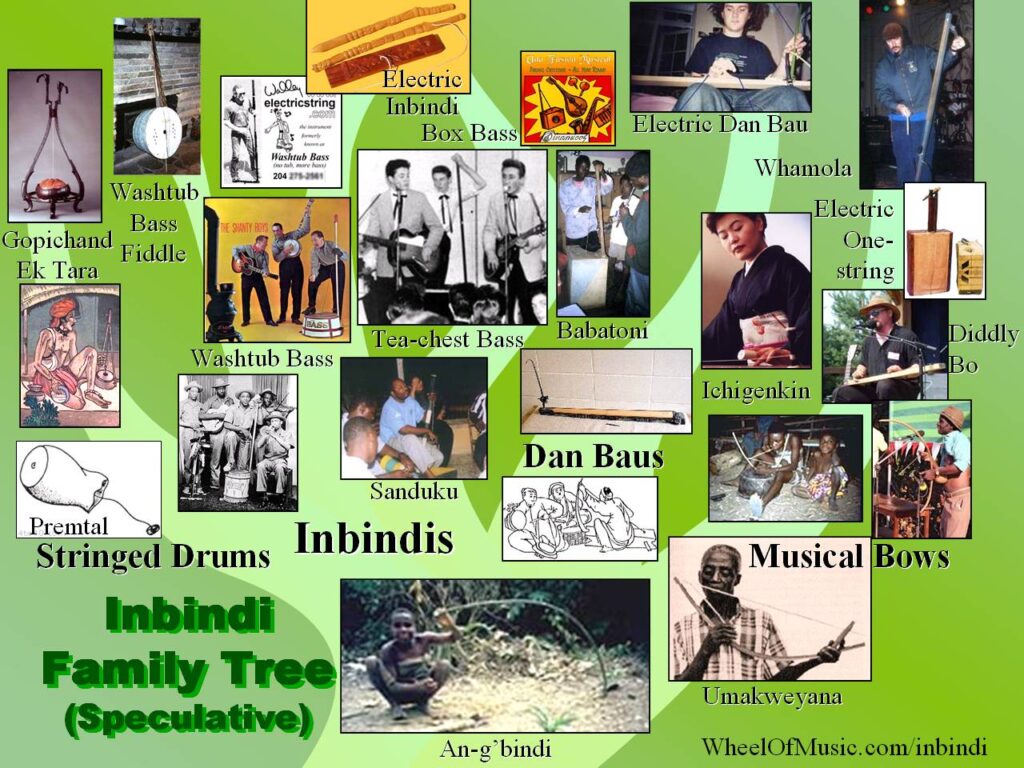
There is plenty of information on the web about the inbindi and related instruments – any search engine can get you started if you know some of the many names for the instrument. A search for only one of the names may put a slant on the results. For instance, there’s lots of info on the washtub bass, but it tends to be slanted towards one kind of music and one type of construction.
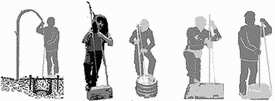
If you are a tea-chest bass player wondering why your instrument is called a washtub bass by Americans and a bush bass by Australians, we take a stab at some answers on this page. The short answer is that the instrument has dozens of sometimes-ambiguous names, and not a single name. To sort out the confusion, we settled on the name ‘inbindi‘ after some digging through the library and the Internet.
There is more information to be found about all versions of the inbindi, and we hope this is a good place to start. It helps to start with a list of as many names as possible. What follows are all the ancient and modern names we could find for acoustic and electric versions of inbindis and closely related instruments. The common names will yield plenty of search results. When we find especially good but obscure links, we give them.
No doubt there are errors on this page, for which we apologize in advance. Finding information about traditional versions of the instrument is a challenge. Part of the challenge is that non-playing observers may not notice details of playing technique that make a big difference in the sound, use and family tree of an instrument.
We are grateful for any additions, corrections or further research you send our way.
Playing Styles

The washtub bass and tea-chest bass are commonly played by altering the tension of the string by pulling back on a free-moving staff. The exact same instruments may be played at least two different ways, both involving a change in the effective length of the string.
The most common method of changing the length of the string is to hold it against the staff at different points with the top hand (you might want to get some gloves before trying this). This method is often called “fretting” as it suggests the way a fretted guitar is played (although “stopping” might be more correct). Often, fretting is adopted by players who assume it is the best (or only) way to play correct pitch. We may disagree, but we have also heard some great performances in the fretting style.
Less common playing methods include producing harmonics, and, sliding a heavy object along the string, a bottle or metal rod for instance, similar to the way a lap steel guitar is played.
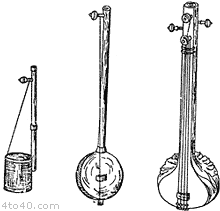
There are various ways of starting the vibration of the string, including plucking, hitting, bowing, or quickly tensioning the string starting from slack. Depending on the exact design of the instrument, there may be additional playing opportunities including beating or slapping the resonator or staff.
Same Instrument – Different Instrument
The slide and fretting styles may lead to an evolution of the instrument. As has happened many different times in many different places, the staff may be rigidly attached to the resonator, or, a fingerboard may be added. The inbindi-like washtub bass has often evolved into what we would call a ‘home-built bass fiddle‘. Call it a washtub bass if you want, but it is no longer an inbindi-like instrument.
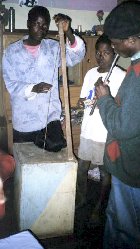
As an aside, the bass fiddle has its own long list of sometimes-ambiguous names – ‘bass’, ‘stand-up bass’, ‘upright bass’, ‘acoustic bass’, ‘string bass’, ‘double bass’, ‘bass viol’, ‘bull fiddle’, ‘doghouse bass’, ‘contrabass’, ‘concert bass’,…. We try to stick with ‘bass fiddle’ for clarity.

Similar ambiguity surrounds the name ‘one-string bass‘. Many times this refers to an inbindi-like instrument, but not always (e.g. the bass sintir, which is closer to a bass guitar). Unless you find a picture to go with a particular name, it is hard to know (and sometimes even a picture isn’t enough to be certain).
The ambiguity is not limited to the English language. For example, ‘ek tara‘ translates as ‘one string’, and depending on the region in India, can refer to a premtal (drum with plucked string attached), a gopichand (variable-tension supported string with drum resonator), or a tuntune (guitar-like single-string single-note drone instrument).
Inbindi Defined
To help sort out some of the confusion, we have settled on ‘inbindi‘, an alternate spelling of ‘angbindi‘, which seems to be a version of the instrument as close to its roots as we have found. It is a little easier to pronounce (‘angbindi‘ itself is only an approximation of the original word from the Congo – ‘an-g’bindi‘), and we think it captures some of the flavor of other traditional names. We use ‘Inbindi‘ as the generic name for instruments played by pushing or pulling on a staff to alter the tension of a single string.
The List
Here is our list [numbers in brackets refer to book sources listed at the end]:
A
‘Anandalahari’ (see Gopichand)

‘Angbindi’ (see Ground Harp) (also spelled an-g’bindi or inbindi) – Baka people of the Congo. This example of a ground harp is probably typical of the oldest inbindi designs.
‘Arc-en-terre’ (see Ground Bow) – French for ‘ground bow‘. [1]
‘Awunene’ – Teso of Uganda, used as a child’s toy. [1, 3]
B
‘Babakungbu’ – Mamvu of the Congo. [1, 4]
‘Babakungu’ – Mari Andosi and Apanga of the Congo. [1, 4]
‘Babatoni’ – Southern Africa. Name for the inbindi with a box resonator used in Kwela groups. Kwela music reached a peak of popularity in the 1950s, and featured penny whistles as the lead instruments. “Tom Hark” is the most well-known kwela song.

‘Bandingba’ – Mayogo of Danga, and Okonfongwe of the Congo. Musical bow without tuning loop or resonator. The Mayogo of Danga also have it with tuning loop (an extra length of string that allows the player to pull on one end of the bow, or the main string itself, to tighten or loosen the tension on the main string). [1, 4]
‘Bandingba-ga-sende’ – Azande of the Congo. [1, 4]
‘Barrel Bass’ – variation of ‘washtub bass‘ (but sometimes this refers to a drum).
‘Bau Monochord’ (see Dan Bau)
‘Bedrock Beat’ – “The Flintstones” cartoon TV show. A child’s toy consisting of a sturdy cardboard box resonator with a pole up one side, a lever atop the pole and a string running from the lever’s end to the center of the box’s top. (Anyone have one of these? Any pictures?)
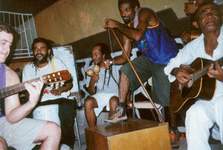
‘Bodongo’ – Bowa of the Congo. [1, 4]
‘Boloye’ – Ivory Coast. We have not been able to determine exactly how this instrument is played. In the meantime, check the photo and decide for yourself. [8]
‘Box Bass’ – Trinidad. An inbindi usually made with a square box resonator, staff at one corner and a round sound-hole in the front. Not to be confused with a bass box which is a bass kalimba (‘thumb piano‘) that uses a number of tuned steel strips mounted on a sound box. With good amplification, this instrument does a credible job of replacing a bass guitar or box bass.

The box bass is traditionally used in Parang music – a lively rhythmic Christmas music, sung in Spanish with some Patois and Latin words. Finding its way into Soca-parang music – an update of Parang with elements of the popular Soca (SOulful CAlypso) style.

‘Brownie Bass’ – New York City, U.S.A.
A classic washtub bass built, played, promoted and sold by Lionel Kilberg during the American folk music revival of the 1960s. Topped with a miniature fire hydrant and named in honor of his dog.
‘Bucket Bass, Wash-bucket Bass, Muck-bucket Bass’ (see Gut-bucket Bass) – variation of ‘gut-bucket bass‘ which is in turn a variation of ‘wash-tub bass‘.
‘Bush Bass’ – Despite its name, this inbindi does not appear to have originated in the Australian outback. Rather, it is a tea-chest bass that seems to have been imported via the docks from the U.K. or Africa, in the early 1950s, around the time of the Skiffle Music and Kwela crazes. It was adopted by a number of bands to accompany Australian folk songs. These days the resonator may be anything from a chest to a tub to a gas tank.
C

‘Cai Trong Kuan’ (see Ground Zither)
‘Chest Bass’ (see Tea-chest Bass)
‘Chonka’ (see Premtal)
D
‘Dàn Bâù, Bass Danbau, Electric Danbau, Dan Doc Huyen, Bau Monochord’ – Vietnam. It has a long narrow sound box and a tall curved stem inserted at one end. A single string runs from one end to a small (now only ornamental) gourd attached to the stem. The stem is bent to change the pitch of the string (like a whammy bar on a guitar), and the player touches the string lightly with the heel of the hand to produce harmonics while plucking.
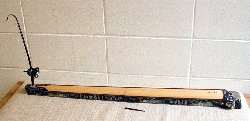
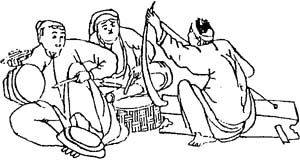
In recent years an electric version has been introduced.
The bass dan bau was adapted to provide a musical range equivalent to that of a bass guitar. When you think about it, it’s an inbindi on its side, or perhaps an inbindi that has been stretched horizontally and shrunk vertically.
Historical illustrations, going back as far as the 11th century, suggest that the dan bau evolved from an instrument even more like an inbindi – a tensioned harp played from a seated position.

The ichigenkin may be a further evolution of the dan bau. It is a traditional Japanese instrument consisting of a single plank of figured hardwood, a single silk string, and one tuning peg. It is played by plucking and a combination of producing harmonics and sliding a weight along the string. Believed to have originated in the Shikoku region, at one time the ichigenkin was the preferred instrument for scholars, Zen priests, and samurai.
Today, a small school of players continues to keep the ichigenkin tradition alive. The playing of harmonics suggests it developed from the dan bau, although in design it is like the diddley-bow (see below).

‘Electric Dan Bau’
The overlap in designs and play has resulted in modern innovators combining the diddley-bow, the dan bau, and the ichigenkin into new electric instruments (and some fanciful names such as electric diddly dan bo). Link to Dan Bau. Link to Electric Dan Bau.
‘Depression Bass’ (see Washtub Bass)

‘Dan Doc Huyen’ (see Dan Bau)
‘Diddley-Bo, Diddly Bow, Bass Diddly-Bo’ – Southern U.S.A. Not an inbindi, but shares enough to be of interest (one string, no frets, part of early history of Blues and Rock and Roll, has been electrified). Similar to the African umakweyana, the instrument could be called a one-string slide guitar. Different notes are played by sliding a bottle, pocket knife or similar object along the string. Usually home-made by stringing a wire between two nails on a board, a door frame or the side of a building.
The instrument is often electrified these days.
(Relationship to blues musician Bo Diddley is unconfirmed, but dare we say, fairly obvious.)
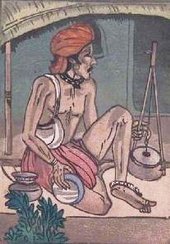
E
‘Earth Bow’ (see Ground Bow)
‘Earth Harp’ (see Ground Harp)
‘Ektara, Ek Tar, Eka Nada, Iktara’ (see Gopichand)
‘Ekitulege’ – Toro and Konjo of Uganda, used as a child’s toy. [1, 3]
‘electricstring’ – what we called our first electric inbindi model, before moving on in design when we discovered the rich heritage of the instrument.

‘Electric Root Bass’ – Portland, Jamaica version of the inbindi, using mic or electric pickup instead of a resonator.
G
‘Gopichand’ – appears to be the result of an addition to the premtal (see below) – the supports are no doubt less tiring than using arm muscles to tension the string. The supports also allow one-handed playing.
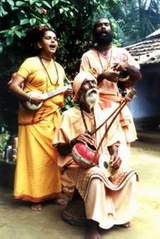
Ornate formal examples of the gopichand exist, dispelling any image of the instrument being only for poorer travelling minstrels. For some players, the single string represents one God or the oneness of the universe. Taking this idea further, sometimes these instruments and variations such as the tuntina (tuntune), are played as single-note drones with no pitch variation. With others, such as the gotu vadyam, the pitch is varied by sliding an object along the string (like a diddley-bow).
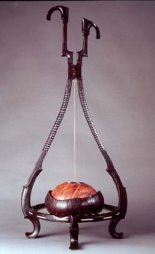
‘Gopijantro’ (see Premtal)
‘Gopiyantra’ (see Gopichand)
‘Gotu Vadyam’ (see Gopichand)
‘Ground Bass’ (see Ground Bow)
‘Ground Bow’ – technical, ethno-musicological and sometimes incorrect variation of ‘ground harp‘. A true ground bow resembles an archer’s bow, with one end of the bow resting on the resonating covering of a pit. [1].
‘Ground Harp’ – technical and ethno-musicological name. If refering to what we call an inbindi, this is technically more correct than ‘ground bow‘.
By definition, a harp’s string or strings pull up on a resonator (not like a guitar where strings rest on a bridge and run just above and along the surface of the resonator). A true ground harp has a string pulling up on a resonator – a piece of bark or stretched animal skin covering a pit dug in the ground. [1]

‘Ground Zither’ – yet another variation on ‘ground harp (“zither” refers to an instrument where the string or strings are some distance away from the resonating body of the instrument, or an instrument with a detachable resonator). Also used to denote an instrument with a second, horizontally stretched rope with the vertical rope tied near its center (thus it has three sections of rope, each of which can vibrate and contribute to the sound).
Also known as: amponga, amponga fantrotrarana, amponga-tany, pitikilangy, tsipakilangay – Malagasy; cai trong kuan – Vietnam; gendang batak – Malayasia; kakalari – Logo of the Congo; kikilo, tsitsilo – Dongo of the Congo; kudrekene – Watsa-Gombari region of the Congo; kudrenene – Daka, Andowi, Azo, Andeu, Andekote and Andemanza of the Congo; kudru-gu – Kilima and Andemanza of the Congo; kuze-gene – Balese, Atolo and Andimbi of the Congo;
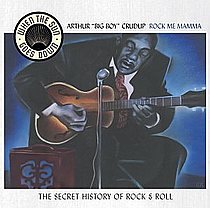
tiduran – Java (has a bridge resting on the pit’s cover tindi de kileru – Mamvu and Djodje of the Congo. [1]
‘Guba, Gubgubi’ (see Premtal)
‘Gutbucket Bass, Gut-bucket Bass’ – Colorful variation of ‘washtub bass‘ – apparently the ol’ tub had a number of uses. Also refers to a kind of music – Gutbucket Blues was a regional style around Memphis and Louisville, the centers of Jug Band music. Obviously, there is a great deal of crossover influence between the musical styles (read more under ‘ washtub bass‘), but the term ‘Gutbucket Blues’ was still being used 20 years after the heyday of Jug Band music with its gutbucket basses.
Sam Phillips of Sun Records (Elvis Presley’s first producer) refers to the kind of music he recorded as ‘gutbucket’ – “I didn’t start Sun until the end of ’52. And, boy, I wasn’t interested in having music as great as all those labels like Atlantic and Specialty and Imperial. I wanted gutbucket white and black, but I didn’t want country, as such…”.

Of Presley’s first record, a version of Arthur “Big Boy” Crudup’s “That’s All Right Mama”, Phillips said “It was a gutbucket thing, but with up-tempo it became an R&B thing.” Crudup is sometimes called the ‘Father of Rock and Roll’, and had the career and regional fame that a young Presley wanted to duplicate.
Sam Phillips quote
H
‘Hillbilly Bass’ (see Washtub Bass) – Another name for washtub bass, referring to a nickname for the people of Appalachia. (More often than not, the name refers to a fish, so good luck searching for this one.)
I
‘Ichigenkin’ (see Dan Bau)
‘Igbombo’ – Nepoko Pygmies of the Congo. A rattan string is attached at one end to a flexible vertical stick, at the other to a piece of bark laid over a nearby pit and tied down. The performer plucks the strings with his left hand while beating the bark with a drumstick. [1, 4, 7]

‘Ikpwokpwo’ – Andekelao Pygmies of the Congo. Alternate name for ‘papakungbu‘. [1, 3]
‘Iktar, Ik tar, Iktara’ (see Gopichand)
‘Inbindi’ – version of ‘an-g’bindi‘, a generic name for any instrument with a free-moving staff, normally played by pulling or pushing on the staff to alter the tension of a single string.
‘Itikili’ – Lugbara of Uganda, used as a child’s toy. [1, 3]
‘Itumbilongonda’ – Bokote of the Congo. [1, 4]
‘Itumbolongonda’ – 1. Beloko of the Congo – A musical bow. 2. Nkundo of the Congo, musical bow without tuning loop or resonator. [1, 4]
J
‘Jamidika’ (see Premtal)
‘Jigi-jigi’ – Alur of Uganda, used as a child’s toy. [1, 3]
K

‘Kakalari’ (see Ground Zither)
‘Kalindula Bass’ – Zambia. Traditional bass instrument that gave its name to Kalindula music, which has now become a general term for Zambian pop music. A few websites refer to the instrument as a one-string bass, even a tea-chest bass. Photos from other sites seem to indicate it is a home-built cross between a traditional instrument and an electric bass guitar. It is possible that both are correct and the instrument and/or musicians’ preferences have evolved.
‘Khamak’ (see Premtal)
‘Kikilo’ (see Ground Zither)
‘Kiturege’ – Bahaya of Tanganyika, a child’s toy. [1, 5]
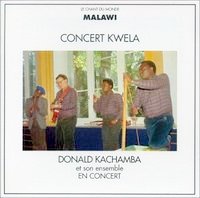
‘Kudrekene, Kudrenene, Kudru-gu’ (see Ground Zither)
‘Kudungbu’ – Amate, Sdoi, Amanga and Andekuju of the Congo. Musical bow without resonator. Amaza, Adoi, Amanga, Andebogo, Andekuju and Atalo of the Congo. Musical bow with tuning loop but no resonator. [1, 4]
‘Kungunangu’ – Mondo of Faradje, the Congo. [1, 4]
‘Kuze-gene’ (see Ground Zither)
‘Kwela Bass’ (see Babatoni) – This alternate name comes from Kwela music.
L
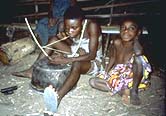
‘Limbindi’ – Baka people of the Congo. Another musical bow, but it is only played by the women and girls. A thin vine is used as the string and a strong pliable and elastic branch is used to make the bow. To change the pitch of the notes the string is held under the player’s chin. As they play they slide their chin forwards and back making the pitch go up and down.
Today players usually sit on the ground and place the limbindi on an upturned cooking pot, which acts as a sound box. The string doubles back on itself. The shorter string is played with the thumb of one hand. The melody is played with the other hand on the longer string using a plectrum made from a small piece of wood or bark.
[www.baka.co.uk/ baka/ instr.htm]
M
‘Malaba, Maloba’ – Gishu of Uganda, used as a child’s toy. [1, 3]
‘Mop-Rope-n-Mic’ – Winnipeg Folk Festival 2004, Canada. We swear, this minimalist inbindi works just fine in a pinch. Tie rope to mop handle (hockey stick, branch, sturdy microphone stand,…). Step on the rope (the challenge is to find just the right spot). Hold the microphone in your top hand so that it physically contacts the mop handle (you may want to bring your own mic so the sound techs don’t freak out).
‘Musical Bow’ – A one-stringed instrument resembling an archer’s bow that makes contact with some form of resonator, possibly a tub, box, gourd, covered pit or the player’s mouth. Pitch may be altered by changing tension, through simple manipulation of the bow, or with an extra length of string called a tuning loop. Not exactly an inbindi, but close enough for some overlap in design.
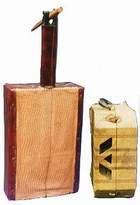
‘Musokolome’ – Soga of Uganda, used as a child’s toy. [1, 3]
O
‘One-string Bass, Electric One-string’ – a simple name many people come up with. Careful – there are other single string basses that are not played the same way, for example, the bass sintir is more closely related to the lute or bass fiddle.
[www.ohek.co.uk/ instruments/ wtpics.htm]
Follow this next link to a picture of the earliest example of a ‘one-string electric bass‘ we have found.
(www.folkartisans.com/ pages/ p-list9.html#prkw)

P
‘Papakungbu’ – Andekelao Pygmies of the Congo. [1, 3]

‘Pitikilangy’ (see Ground Zither)
‘Poor Boy’s Bass’ – We have run across this numerous times in casual conversation. Seems to come from the album “Willie and the Poor Boys” by Credence Clearwater Revival.
‘Premtal (Hindi), Khamak (Bengali), Chonka (Marathi), Jamidika (Telugu), Guba, Gopijantro, Gubgubi,
Ananda Lahari, Ananda Lahori’ – India.
Consists of a bottle gourd or wooden cylinder resonator with a leather bottom through which a gut string is attached. The string runs through the center cavity of the resonator. Here the resemblance to the gopichand ends, for there is no staff or support to hold the string, only a wooden handle or a second smaller drum, attached at the end.
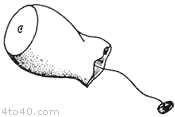
To play the premtal the musician holds the body of the instrument under the arm and the free end of the string in the fist of the same arm. The string is plucked with a wooden plectrum in the other hand.
The instrument is used as a rhythmic instrument, rather than melodic, with only small pitch variations resulting from short, jerky motions. The result is a weird tonal and rhythmic effect. Used by snake charmers and minstrel ballad singers.
S

‘Sanduku’ – Zanzibar.
Traditional inbindi bass, used in groups playing Kidumbak music. The word sanduku translates to ‘box’, ‘chest’, or ‘container’.
‘Sekitulege’ – Ganda of Uganda, a child’s toy [1, 3]
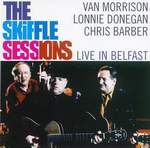
‘Skiffle Bass’ – name comes from Skiffle music.
Lonnie Donegan launched the skiffle craze with his hit “Rock Island Line”. Aspiring musicians found that they could get on stage with some simple songs, one or two inexpensive guitars and a bit of effort to put a broomstick and a tea chest together (although Donegan himself was backed up with a bass fiddle).

Donegan and skiffle music inspired Van Morrison, Pete Townshend, Dr. John, Rod Stewart, Brian May and Rory Gallagher among others. In Liverpool, John Lennon, Paul McCartney and Richard Starkey (later known as Ringo Starr) played in skiffle bands, as early photos of them show.
See tea-chest bass
‘Stick Bass, Stick and String, Rope ‘n’ Stick’ – What a lot of people spontaneously call the electric inbindi the first time they see one. We discourage this because the name is already taken by the ‘Chapman Stick‘, a completely different and beautiful electric multi-stringed instrument played by finger tapping.
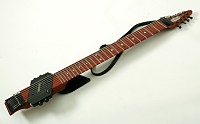
T
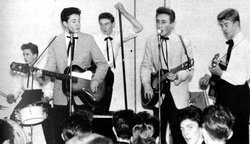
‘Tea-chest Bass, T-chest Bass, Tea-box Bass’ – United Kingdom, Uruguay, Australia, South Africa and ports around the world. An inbindi with a tea-chest resonator, i.e., a lightweight crate made from thin, flexible and hard plywood. Reached a peak of popularity during the skiffle music craze in 1956 and 1957.
The Internet has numerous anecdotal accounts from around the world of tea-chest basses appearing in the 1950s. Many credit sailors as being the source of the designs, which is not surprising given that tea-chests were (and still are) used to ship tea around the world. However, it is not possible to determine a point of origin from the anecdotes because sailors travel, of course. It seems a stretch to claim that a sailor must have been the actual inventor.

South Africa is perhaps the most likely birth-place, but it is not the only possibility, and it is not impossible to imagine more than one person ‘inventing’ the tea-chest bass independently. In any case, the evidence clearly shows numerous older variations of the inbindi existed around the world.
‘Tiduran’ (see Ground Zither)

‘Tilingotalango, Tilingolatango’ – Mexico, Cuba, Canary Islands, Trinidad. Spanish name for the Caribbean version of the inbindi. Also a name for a dance.
‘Tindi de Kileru’ (see Ground Zither)
‘Tingotalango’ – Cuba, Canary Islands, Trinidad.
[1, 6, www.terra.es/ personal/ folias55/ Instrumentos/ tingotalango.htm]
‘Titimotiti’ – Andekote of the Congo. [1, 4]
‘Tsipakilangay’ (see Ground Zither)
‘Tsitsilo’ (see Ground Zither)
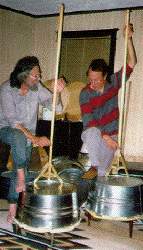
‘Tub Bass’ (see Washtub Bass)
‘Tub-o-tone’ – State-of-the-art design for a fixed staff washtub bass played in the fretting style. Building plans used to be available as part of the Washtub Bass Page / Tubotonia website run by Lauren Miller.
‘Tum’ – Lango of Uganda, used as a child’s toy. [1, 3]
‘Tumbadera’ (see Tilingolatango) – another name for ‘tilingolatango‘ (not a ‘tumbadora‘, which is a drum).
‘Tuntune, Tun Tina’ (see Gopichand)
U
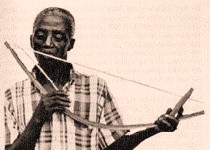
‘Umakweyana, ‘umakhweyana bo’ – West Africa. A musical bow with various levels of design refinements, from a simple mouth-bow to braced gourd-bow.
It is particularly interesting because some single examples of the instrument are played in very different ways at different times.
Pitch can be changed by flexing the bow to change tension in the string, but also by sliding an object along the string (suggesting it is an ancestor of the diddley-bow) and by harmonics – the string yields three fundamentals which resonate differently when manipulating the gourd cavity against and away from the body.
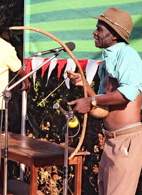
‘Musical Gourd-bow’ – This instrument may be the common ancestor for diddley-bows, guitar-like lutes and various resonator-attached musical bows and mouth bows, as well as being an influence on the evolution of inbindi-like instruments used by early African-Americans.
A version with attached gourd resonator was adopted by the Zulu people in the early 19th century and played by young unmarried women to accompany love songs.
W

‘Washtub Bass, Wash-tub Bass’ – U.S.A., Appalachian Mountains and the South, and now around the world thanks in part to television appearances on the “Beverly Hillbillies”, “Sanford and Son”, “MAS*H”, “Fat Albert (Cosby Kids)” and others. An overturned metal washtub is the usual resonator. Historically, there was a sharp division between the music played by European-Americans of Appalachia and that played by African-Americans throughout the South.
European-Americans played a melody-based “old timey” style with roots in Irish and Scottish folk ballads. Among African-Americans the washtub or gutbucket bass was featured in Jug Bands, which first appeared around 1900 in New Orleans as Spasm Bands and reached a peak of popularity in Memphis and Louisville from about 1925 to 1935.
The energy, fun and rhythmic basis of the style foreshadowed early Rock & Roll. Elvis Presley, who recorded 20 years later just around the corner from the Beale Street epicenter of Jug Band music, and Chuck Berry were no doubt influenced by this legacy.
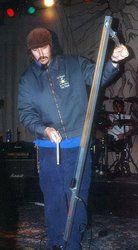
Jug Band music was re-introduced in the 1960s by folk revivalists including Taj Mahal, Dave Van Ronk, Arlo Guthrie and “Mother McCree’s Uptown Jug Champions” – an early incarnation of the Grateful Dead.
‘Whamola’ – a modern invention with one string and a movable lever at the top of its staff for changing the pitch. Often played by hitting the string with a drum stick with the signal heavily distorted electronically. Popularized by Les Claypool of the band Primus.
Z
‘Zuzu’ – Balese of Tshumunange, the Congo. [1, 4]
?

Sometimes there is no explanation
Book Sources
[1] Marcuse, Sibyl. Musical Instruments: A Comprehensive Dictionary. W.W. Norton & Company Inc. New York 1964, 1975.
[2] Sachs, Curt. The History of Musical Instruments, New York 1940.
[3] Wachsmann, K.P., (chapter of musical instruments), in Trowell, M., and Wachsmann, K.P.: Tribal Crafts of Uganda, London 1953.
[4] Laurenty, J.S. Les chordophones du Congo Belge et du Ruanda-Urundi. Tervueren, 1960.
[5] Jenkins, Jean L. Personal communication with Sibyl Marcuse.
[6] Ortiz, Fernando. Low Instromentos de la música afrocubana. Havana, 1952-55.
[7] Boone, Olga. Les Tambours du Congo Belge et du Ruanda-Urundi. Annales du Musee du Congo Belge. Tervueren, 1936.
[8] Baba L’Rouami [Gnawa Music of Marrakesh Axiom 539 881-1:a1].